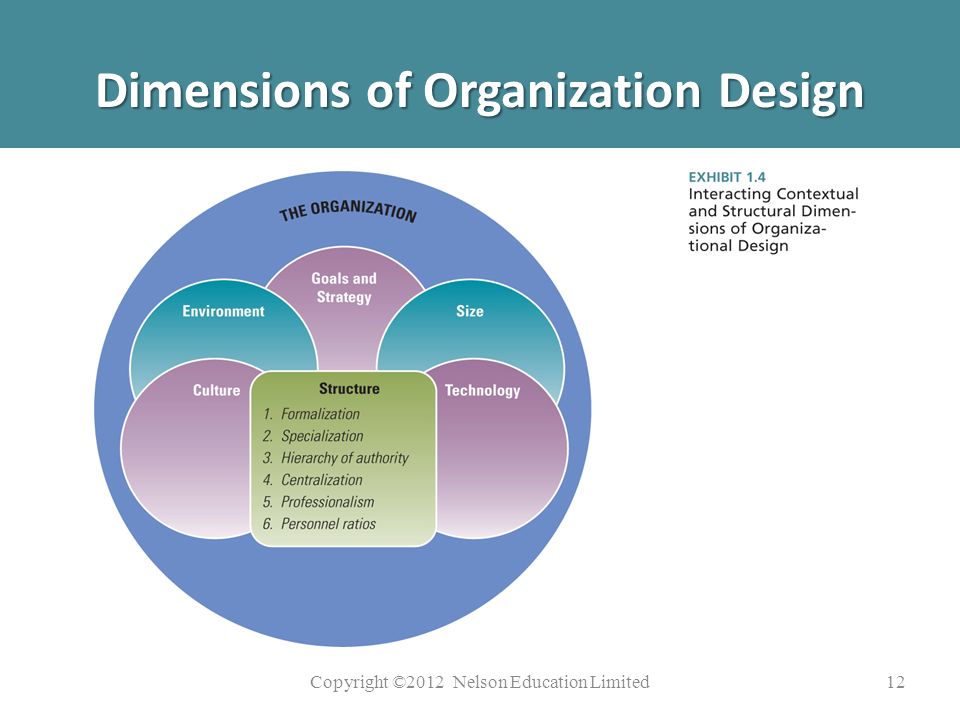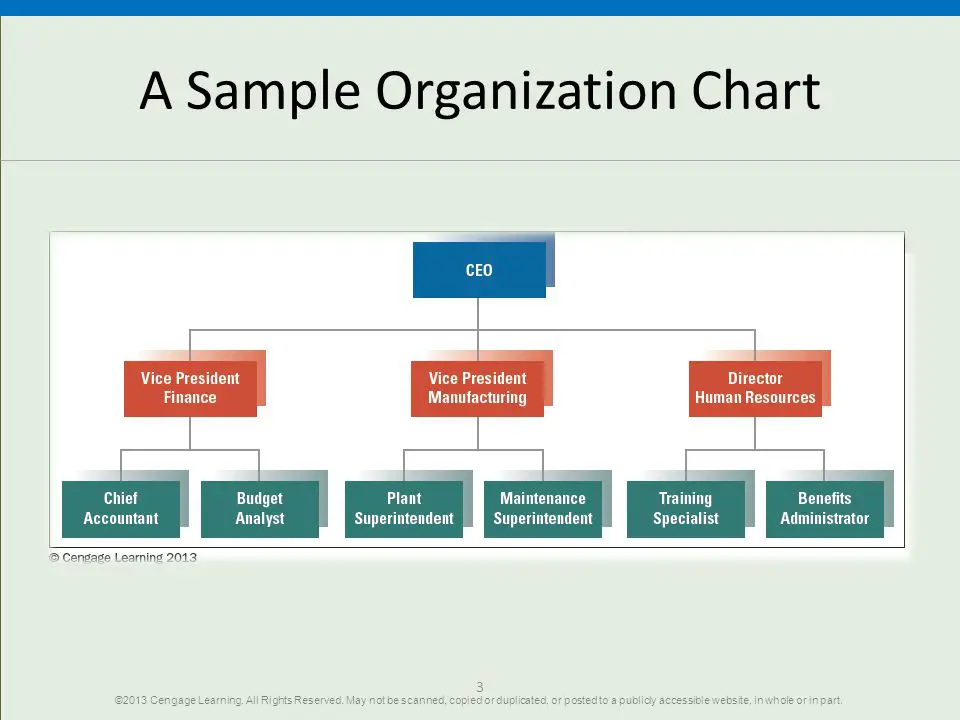Dimensions of Organization Design
OrganizationsOpens in new window shape our lives, and well-informed managers can shape organization. The first step to understand organizations is by examining the features that describe specific organizational design traits.
These features describe organizations in much the same way that personality and physical traits describe people.
Figure X-3 illustrates two types of interacting features of organizations: structural dimensions and contingency factors.
 Figure X-3. Credit — Slideplayer Opens in new window
Figure X-3. Credit — Slideplayer Opens in new window
- Structural dimensions provide labels to describe the internal characteristics of an organization. They create a basis for measuring and comparing organizations.
- Contingency factors encompass larger elements that influence structural dimensions, including the organization’s size, technology, environment, culture, and goals.
Contingency factors describe the organizational setting that influences and shapes the structural dimensions. Contingency factors can be confusing because they represent both the organization and the environment.
These factors can be envisioned as a set of overlapping elements that shape an organization’s structureOpens in new window and work processes, as illustrated in Figure X-3.
To understand and evaluate organizations, one must examine both structural dimensions and contingency factors. These factors of organization design interact with one another and can be adjusted to accomplish the purposes listed earlier in Figure X-2Opens in new window.
Structural Dimensions
Key structural dimensions of organizations include the following:
- formalization,
- specialization,
- hierarchy of authority,
- complexity, and
- concentration.
- Formalization
Formalization pertains to the amount of written documentation in the organization. Documentation includes procedures, job descriptions, regulations, and policy manuals.
These written documents describe behavior and activities. Formalization is often measured by simply counting the number of pages of documentation within the organization.
Large universities, for example, tend to be high on formalization because they have several volumes of written rules for such things as registration, dropping and adding classes, student associations, dormitory governance, and financial assistance. A small, family-owned business, in contrast, may have almost no written rules and would be considered informal.
- Specialization
Specialization (sometimes referred to as the division of labor) is the degree to which organizational tasks are subdivided into separate jobs.
- If specialization is extensive, each employee performs only a narrow range of tasks.
- If specialization is low, employees perform a wide range of tasks in their jobs.
- Hierarchy of Authority
Hierarchy of authority describes who reports to whom and the span of control for each manager.
The hierarchy is depicted by the vertical lines on an organization chart, as illustrated in Figure X-4. The hierarchy is related to span of control (the number of employees reporting to a supervisor).
 Figure X4 | A Sample of Organization Chart
Figure X4 | A Sample of Organization Chart
|
When spans of control are narrow, the hierarchy tends to be tall. When spans of control are wide, the hierarchy of authority will be shorter.
- Complexity
Complexity refers to the number of distinct departmental units or activities within the organizations. For example, GEOpens in new window was incredibly complex.
Complexity can be measured along three dimensions: vertical, horizontal, and spatial.
- Centralization
Centralization refers to a setup in which the decision-making powers are concentrated in a few leaders at the top of the organizational structure.
Centralization is characterized by the degree of delegation of decision making authority. Whereas low degrees of centralization means that employees have high discretion over decisions; high degrees of centralization means that employees have little discretion over decisions.
A high degree of centralization means that there are few decisions makers in the organization.
For reason of space, we will discuss the contingent factors of organizations in the next volume.
Featured contents in the series:
- What Is an Organization?Opens in new window
- Multinational vs Non-Profit OrganizationsOpens in new window
- Organization DesignOpens in new window
- Structural Dimensions of Organization DesignOpens in new window
- Contingent Factors of Organization DesignOpens in new window
- Organic versus Mechanistic DesignOpens in new window
- Organizational Design AlternativesOpens in new window
- Research data for this work have been adapted from the manual:
- Managerial Accounting: Tools for Business Decision Making By Jerry J. Weygandt, Paul D. Kimmel, Donald E. Kieso
Contingent Factors
Key contingent factors of organizations include:
- Organizational size,
- Organizational technology
- Environment
- Organization’s goals and strategy, and
- Organization’s culture.
- Organization’s Size
- Organization’s Technology
- Environment
- Organization’s Goals and Strategy
- Organization’s culture
- Customers, who want high quality products and services provided in a timely manner at a reasonable price.
- Employees, who want adequately pay and benefits, good working conditions, and appropriate supervision.
- Stockholders, who want a good financial return on their investment.
- Structural dimensions and contingency factors provide labels for measuring and analyzing an organization. These characteristics may vary widely from organization to organization.
- Structural dimensions include formalization, specialization, hierarchy of authority, complexity, and centralization.
- Contingency factors include size, organizational technology, environment, goals and strategy, and culture.
- Managers strive to design organizations to achieve both efficiency and effectiveness.
- Defining clear goals and measuring progress toward achieving them is the most common approach to measuring effectiveness.
- What Is an Organization?Opens in new window
- Multinational vs Non-Profit OrganizationsOpens in new window
- Organization DesignOpens in new window
- Dimensions of Organization DesignOpens in new window
- Organic versus Mechanistic DesignOpens in new window
- Organizational Design AlternativesOpens in new window
- Managerial Accounting: Tools for Business Decision Making By Jerry J. Weygandt, Paul D. Kimmel, Donald E. Kieso
Organization’s size is typically measured by the number of employees. Other measures such as total sales or total assets also reflect magnitude, but they do not indicate the size of the human part of the system. GE was very large, with hundreds of thousands of employees.
Organizational technology refers to the tools, techniques, and actions used to transform inputs into outputs. It concerns how the organization actually produces the products and services it provides for customers and includes such things as flexible manufacturing, digital information systems, and the Internet. An automobile assembly line, a social media platform, a college classroom, a ride-hailing app, and an overnight package delivery system are technologies, although they differ from one another.
The environment includes all elements outside the boundary of the organization. Key elements include the industry, government, customers, suppliers, and the financial community. The environmental elements that affect an organization the most are often other organizations.
The organization’s goals and strategy define the purpose and competitive techniques that set it apart from other organizations. Goals are often written down as an enduring statement of company intent. A strategy is the plan of action that describes resource allocation and activities for dealing with the environment and for reaching the organization’s goals. Goals and strategies define the scope of operations and the relationship with employees, customers and competitiors.
An organization’s culture is the underlying set of key values, beliefs, understandings, and norms shared by employees. These underlying values and norms may pertain to ethical behavior, commitment to employees, efficiency, or customer service, and they provide the glue to hold organization members together. At GE, for example, Jack Welch implemented Work-Out sessions to create a culture of open and direct conversation among employees and managers.
The five structural dimensions and five contingency factors discussed here are interdependent. Certain contingency factors will influence the appropriate degree of specialization, formalization, and so forth for the organization. For example, large organization size, a routine technology, and a stable environment all tend to create an organization that has greater formalization, specialization, and centralization.
The organizational features illustrated in Figure X-3 provide a basis for measuring and analyzing characteristics that cannot be seen by the casual observer, and they reveal significant information about an organization. Consider, for example, the dimensions of Valve Software compared with those of Walmart. Valve is a small organization that ranks very low with respect to formalization and centralization and has a medium degree of specialization. Horizontal collaboration to serve customers with innovative product is emphasized over the vertical hierarchy. Walmart is much more formalized, specialized, and centralized, with a strong vertical hierarchy. Efficiency is more important than new products and services, so most activities are guided by standard regulations. Rules are dictated from the top and communication flows down a strong vertical chain of command.
Structural dimensions and contingency factors can thus tell a lot about an organization and about differences among organizations.
Performance and Effectiveness Outcomes
The whole point of understanding structural dimensions and contingency factors is to design the organization in such a way as to achieve high performance and effectiveness. Managers adjust various aspects of the organization to most efficiently and effectively transform inputs into outputs and provide value.
Efficiency refers to the amount of resources used to achieve the organization’s goals.
It is based on the quantity of raw materials, money, and employees necessary to produce a given level of output.
Effectiveness is a broader term, meaning the degree to which an organization achieves its goals.
defining goals and measuring the organization’s progress toward attaining them is the most common way managers assess effectiveness. For example, at GE, described here, Jeff Immelt set new goals for sustainability, as well as goals in other areas, such as innovation and global growth. A small hardware store might set weekly sales goals. In a manufacturing company, managers might set specific targets in areas such as conformity-to-specializations quality, flexibility (both product mix and volume), and speed and timeliness of delivery. To be effective, all organizations need clear, focused goals and appropriate strategies for achieving them. The concept of effectiveness, including goals and strategies and various approaches to measuring effectiveness are here.
An alternative approach to measuring effectiveness, the “stakeholder approach, assess diverse organizational activities by looking at what various organizational stakeholders want from the organization, and the satisfaction level of each.
A stakeholder is any group within or outside of the organization that has a stake in the organization’s outcomes.
Examples of stakeholders include:
Managers carefully balance the needs and interests of various stakeholders in a setting goals and striving for effectiveness. The satisfaction level of each group can be assessed as an indication of the organization’s performance. The stakeholder approach will be discussed elsewhere.
| Remember This |
|---|
Featured contents in the series:
- Research data for this work have been adapted from the manual:

